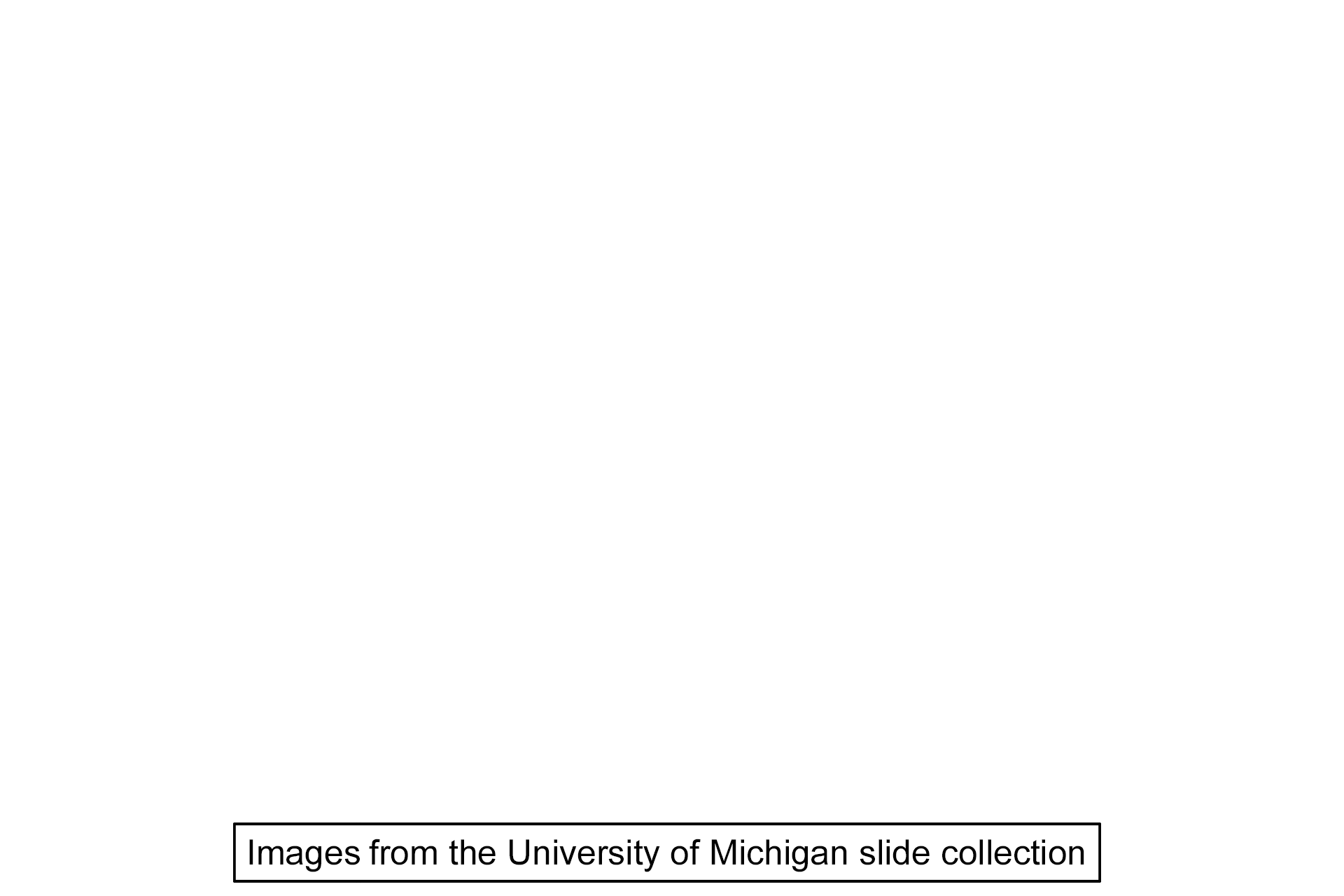
Root stage of tooth development - Neck region
The image on the right shows the region of the tooth where the cementum and enamel meet (indicated in the lower magnification image on the left). The junction marks the transition from the crown of the tooth to the root. 10x (l), 600x (r)

Ameloblasts >
The columnar ectodermal cells on the inner aspect of the enamel organ that deposit the organic matrix of enamel are fully differentiated ameloblasts. During the crown stage of tooth development the pre-ameloblasts fully differentiate into ameloblasts that deposit enamel starting at the cusp of the tooth and moving apically. Ameloblasts have a shovel-shaped process at their base called Tomes process, that is visible in this micrograph as a light line

- Tomes' processes
The columnar ectodermal cells on the inner aspect of the enamel organ that deposit the organic matrix of enamel are fully differentiated ameloblasts. During the crown stage of tooth development the pre-ameloblasts fully differentiate into ameloblasts that deposit enamel starting at the cusp of the tooth and moving apically. Ameloblasts have a shovel-shaped process at their base called Tomes process, that is visible in this micrograph as a light line.

Enamel
The columnar ectodermal cells on the inner aspect of the enamel organ that deposit the organic matrix of enamel are fully differentiated ameloblasts. During the crown stage of tooth development the pre-ameloblasts fully differentiate into ameloblasts that deposit enamel starting at the cusp of the tooth and moving apically. Ameloblasts have a shovel-shaped process at their base called Tomes process, that is visible in this micrograph as a light line

Cemento-enamel junction >
The cemento-enamel junction is the site where enamel deposition ends and cementum deposition begins. This junction is located in the neck region of the tooth.

Cementum
Cementum is a thin layer of bone-like tissue that covers the dentin from this junction to the root of the tooth. The tooth is stabilized in the tooth socket by anchoring collagen fibers of the periodontal ligament, which extends from cementum to alveolar bone.

- Cementoblasts >
Cementoblasts deposit the organic matrix of cementum which rapidly becomes mineralized by hydroxyapatite. Scattered cementocytes are visible within cementum.

- Cementocytes
Cementoblasts deposit the organic matrix of cementum which rapidly becomes mineralized by hydroxyapatite. Scattered cementocytes are visible within cementum.

Dentin
Dentin is the first hard tissue deposited during tooth development and makes up the majority of the hard tissue of the tooth. Dentin is produced by odontoblasts, which, like ameloblasts, secrete an organic matrix that rapidly becomes mineralized with hydroxyapatite crystals.

- Odontoblasts >
Odontoblasts line the pulp cavity and deposit dentin similarly to bone. The organic matrix, called predentin, is deposited first and provides a framework on which hydroxyapatite crystals are laid down. Mineralized dentin is more darkly stained. A layer of pre-dentin is present throughout the life of the tooth.

- Tomes' fibers >
Tomes’ fibers are odontoblast processes that are responsible for forming dentin and extend into the dentinal tubules toward the cementum of the tooth. They provide sensitivity to the tooth and elongate as dentin matrix formation continues.

- Predentin
Odontoblasts line the pulp cavity and deposit dentin similarly to bone. The organic matrix, called predentin, is deposited first and provides a framework on which hydroxyapatite crystals are laid down. Mineralized dentin is more darkly stained. A layer of pre-dentin is present throughout the life of the tooth.

Dental pulp >
At the root stage of tooth development the ectomesenchymal cells of the dental papillae have fully differentiated into the dental pulp organ. This will form the dental pulp that houses the odontoblast cell bodies, nerves, and many blood vessels.

Image source >
These images were taken of a slide in the University of Michigan slide collection.